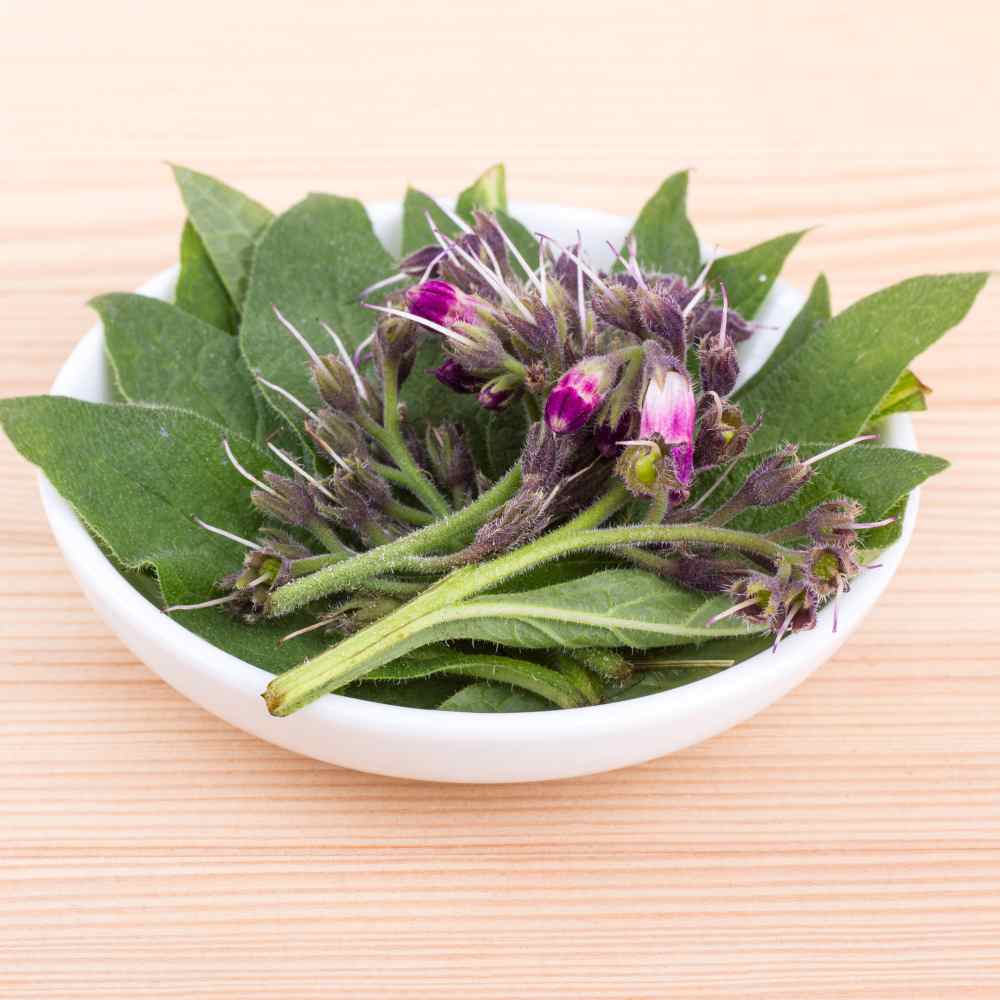New Account | Seed Mix |
Gift Certificates |AAS Winners |
Gardening Products
SEEDS: Unusual | Annuals | Perennials | Vegetables | Herbs | Trees
Comfrey Seeds
Comfrey is toxic to the liver for both humans and livestock and should not be taken orally or used on open wounds.
Comfrey can be planted spring, summer or fall, anytime the soil can be worked. In warmer climates (Deep South and Southwest USA), it can be planted and the leaves harvested throughout the year.
Comfrey grows best in USDA Hardiness Zones 3-9. But will grow almost anywhere. Comfrey prefers a sweet soil with a pH of 6.0-7.0 and grows best in rich, moist soil in full sun, but will tolerate some shade. It will grow well in clay, light sands or loams — whether in dry or wet areas. Strong growing and deep- rooted, Comfrey adapts well to most any environment.

3449 Common Comfrey ( Symphytum officinale )
Comfrey has been used as a healing herb for centuries. The comfrey herb is native to Asia and Europe, but early English immigrants brought it to North America for medicinal purposes. Common Comfrey, Latin name: Symphytum officinale, grows to be approximately 60 inches tall. It has slender lance-shaped leaves and produces bell-shaped purple flowers that bloom from May to September. Comfrey, even when grown from Comfrey seed, has a deep root system with thick dark-colored roots. Comfrey may have violet, pink or creamy yellow flowers.
Comfrey contains chemicals that speed up wound healing. It has astringent, antifungal and antibacterial properties. Comfrey also contains a wide variety of healthy chemicals and nutrients. It has been recently learned that it can be a carcinogenic when taken internally, but it is still used as a topical treatment for skin irritations, cuts, sprains and swelling.
The form and size of the Comfrey herb might have you thinking it is a shrub, but it will die back to the ground in the winter and it does not get woody. Comfrey has a deep tap root, so it is extremely drought tolerant and a useful clay busting plant. It is also useful as a slug and snail repellent.
Leaves can be harvested and dried at any time. If you are growing it to harvest the leaves, you can make your first cutting when the plants are about 2 feet tall. Cut back to within a few inches of the crow. If you begin harvesting early, you won't get flowers. Leaves, flowers and roots have all been used in traditional medicine, but use extreme caution if you don't know what you're doing. Comfrey should never be taken orally and even a topical application can cause problems.
Comfrey is a beautiful addition to any border and is great for grabbing attention to the back of a border. Comfrey's tall height makes it a perfect candidate to grow around trees in an orchard. As a nutrient accumulator, comfrey mines the subsoil for nutrients (potassium, phosphorus, calcium, and more).
Perfect for permacultures. Attracts pollinators. Provides habitat for beneficial insects. Fertilizes with nutrient-rich mulch. A perennila for zones 4-9.
Comfrey contains chemicals that speed up wound healing. It has astringent, antifungal and antibacterial properties. Comfrey also contains a wide variety of healthy chemicals and nutrients. It has been recently learned that it can be a carcinogenic when taken internally, but it is still used as a topical treatment for skin irritations, cuts, sprains and swelling.
The form and size of the Comfrey herb might have you thinking it is a shrub, but it will die back to the ground in the winter and it does not get woody. Comfrey has a deep tap root, so it is extremely drought tolerant and a useful clay busting plant. It is also useful as a slug and snail repellent.
Leaves can be harvested and dried at any time. If you are growing it to harvest the leaves, you can make your first cutting when the plants are about 2 feet tall. Cut back to within a few inches of the crow. If you begin harvesting early, you won't get flowers. Leaves, flowers and roots have all been used in traditional medicine, but use extreme caution if you don't know what you're doing. Comfrey should never be taken orally and even a topical application can cause problems.
Comfrey is a beautiful addition to any border and is great for grabbing attention to the back of a border. Comfrey's tall height makes it a perfect candidate to grow around trees in an orchard. As a nutrient accumulator, comfrey mines the subsoil for nutrients (potassium, phosphorus, calcium, and more).
Perfect for permacultures. Attracts pollinators. Provides habitat for beneficial insects. Fertilizes with nutrient-rich mulch. A perennila for zones 4-9.
Share a growing tip or recipe and help other gardeners!
Click on the Contact Form link, place "Tip" in the name line and fill in your information. If we accept your Comfrey growing tip, we will post it on this page.
